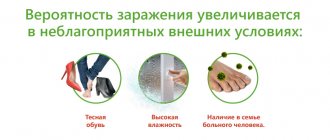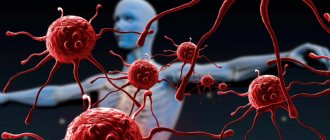Just a few years ago, fungal nail diseases were not given much importance, whereas now everyone understands the need for timely detection and treatment of a massive contagious fungal infection caused by a variety of dermatophyte fungi. Thanks to widespread public awareness, the number of visits to specialists with this pathology has increased, which in turn has led to an increase in the detection of mycoses of the feet. Since any deformation of the nail plate for no apparent reason (for example, injury) is primarily suspected of a fungal infection, self-diagnosis in this case is a decisive factor. Thus, any change in the nail plate is a reason to contact a dermatologist, because at least half of such disorders will have a fungal etiology, and the rest will require careful diagnosis, again carried out by a specialist.
Why, given the obvious simplicity of clinical diagnosis of fungal nail infections, do patients usually come to the appointment already with advanced forms of the disease? Most often, 4-5 toes are affected, with the most affected nail plate (usually the first toe) changed by more than half, and its thickening is about 2 mm. Such symptoms require long-term combined treatment, which is reflected in its cost. Factors leading to this situation:
1. Actually, fungal nail infection is a sluggish disease that does not lead to life-threatening conditions and does not cause pain or discomfort. More often it affects the elderly population, who often associate changes in appearance with the aging process.
2. The sick themselves are often embarrassed by the disease, are not prepared for the financial costs of treatment, or are confident that it is incurable. Many people begin to self-medicate and do not see the disease as a reason to see a specialist.
3. Since the disease primarily affects the feet, even during medical examinations or examinations by doctors, the matter usually does not reach the point of examining the feet directly, without specific patient complaints about changes in the nails. This is facilitated by the extremely short time allotted for seeing patients even in specialized institutions, which, unfortunately, forces doctors to examine them only for the main reason for the visit.
Fungal infection of nails lasts quite a long time
Therefore, the earlier the disease is detected, the higher the likelihood of its complete cure. In addition, an earlier start of therapy allows us to limit ourselves to the use of only external preparations and nail cleanings, and this is only possible if the infection has affected single nails from the distal or lateral edges of less than 1/3-1/2 of the plate. Local external therapy is used to treat the initial stages of fungal nail infection. Advanced forms of fungal infection require longer and more expensive treatment. Periodic preventive examinations and medical examinations of the population play a special role in the early detection of nail mycoses.
Symptoms of fungus
The course and development of the disease is influenced by the physiological characteristics of the skin of the feet, increased sweat production, disturbances in the functioning of the endocrine system, and leg injuries. Fungal pathogens can remain dormant for a long time without showing symptoms. If there are disturbances in the body, they can become active. Athlete's foot is characterized by the presence of several forms of the disease, which can be supplemented by damage to the nail plates.
Fungal infection can be determined if several symptoms are present:
- the nail plate changes its natural color: usually yellow or dark color is fixed, but the nails can even become white or completely black;
- tissue keratosis under the plate: outwardly it looks as if a hard growth has appeared under the nail;
- thickening and delamination of the plate;
- deformation of the nail: protrusion, growth to the side, ingrowth into the skin;
- fragility of the nail plate: parts of it may break off.
Useful tips from the doctor
Prevention of nail fungus or how to avoid getting a fungal infection
- Have individual accessories: shoes, slippers, washcloth, pumice stone, foot towel and manicure set.
- After use, wash the bathtub and shower cabin with powder (chlorine) and a cloth.
- Nail scissors are disinfected by immersing them in alcohol and then burning them over a burner flame.
- After contact with surfaces and objects potentially contaminated with fungus (beaches, baths, swimming pools, gyms, other people's shoes, sports equipment, etc.), it is recommended to treat your feet with a spray (for example, MIKOSTOP).
How does the disease progress?
The first manifestations of the disease begin in the spaces between the fingers, especially between 4 and 5, since there is the smallest distance between them. A slight itching begins, and over time a strip of thickened and slightly flaky cuticle appears on the finger fold.
After 2-3 days, a small crack forms, from which serous fluid is released, which acts as an excellent medium for the successful proliferation of the fungus. The tough layer of epidermis may fall away, revealing a dark pink area underneath. The progression of the disease leads to its spread over all the toes and the adjacent side of the foot.
Through damaged areas of the upper part of the skin, the fungus can penetrate into the deeper layers behind the epidermis. The disease is accompanied by an eczematous reaction. Fluid-filled blisters form on the skin, which are very itchy. Over time, they can coalesce and erode, resulting in wet spots.
Reference! When studying skin affected by fungus, it was found that the “bare” wet surface that appears under the blisters does not contain the pathogens themselves, but is only a consequence of their activity.
Without proper timely treatment, the fungus affects the entire surface of the foot and toes, sometimes extending to the area above the heel. There is instability in the course - the disease either slows down or intensifies again.
Without treatment, the disease can drag on for many years. In this case, there is a high risk of complications from pathogenic streptococcus: the fluid in the blisters begins to fester, foci of inflammation spread beyond the initial boundaries, and the foot swells greatly. It becomes difficult for a person to move due to painful sensations in the legs. In addition, complications may arise in the form of problems with the lymph nodes.
The development of athlete's foot usually occurs in the summer months. At this time, sweating increases, fingers often become wet, and increased humidity in the interdigital areas creates favorable conditions for the introduction of fungus and its active reproduction.
Mycosis usually appears on the 1st and 5th fingers, spreading from the free side. The nail gradually thickens, acquires a yellowish tint and an uneven sharp edge. Over time, pronounced subungual hyperkeratosis of varying degrees appears.
Onychomycosis (nail fungus) - symptoms and treatment
There are several types of treatment for onychomycosis:
- Local therapy.
- Systemic therapy.
- Combination therapy.
- Corrective therapy [2].
Local therapy involves applying medications to the nail plate and nail folds. Indications for local therapy:
- Limited form of damage to the nail plate (according to KIOTOS [4]).
- There are contraindications for prescribing systemic drugs: hypersensitivity, liver disease, renal dysfunction, pregnancy, lactation.
The advantages of this therapy are that high concentrations of the therapeutic agent are formed on the surface of the nail, which does not penetrate into the bloodstream. There are no side effects of using antifungal drugs - nausea, loss of appetite, abdominal pain. The disadvantage of the method is that the medicinal substance does not always reach the pathogen's habitat, especially if the fungi are located in the nail bed or matrix. This in turn can lead to treatment failure. This type of treatment is very labor-intensive, since before applying the drug it is necessary to remove the affected part of the nail [2].
Methods for removing affected nails:
- Mechanical removal using files, nippers or a drill.
- Using keratolytic patches. Before applying a keratolytic plaster, the skin around the nail is sealed with a plaster, a plaster mass (urea with salicylic acid) is applied on top and sealed with an adhesive plaster. The plaster mass is changed every 2-3 days. After each removal, the affected part of the nail is removed mechanically.
- Surgical. This operation is very painful and traumatic, since when the nail plate is removed, the growth zone can be damaged, which leads to the regrowth of deformed nails.
Local antifungal agents are used after removing the affected nail plate. Antimycotics are distinguished according to the place of application:
- applied to the nail: varnishes;
- applied to rollers: creams, ointments, solutions.
The most studied drug for topical use is a 1% solution of naftifine , which has an evidence base for effectiveness in treatment based on a Cochrane meta-analysis [8]. This product is water-based, which facilitates better penetration of the antifungal substance into the affected area. Varnishes, the active ingredients of which are ciclopirox and amorolfine, have a dehydrated base, which reduces the penetration of the drug into the deep layers. Therefore, dermatologists consider the use of varnishes unsatisfactory and increasingly prefer water-based products [10].
To get results from local therapy, it is necessary to follow the treatment regimen; it is important for the patient to be responsible, consistent and patient. The duration of therapy can be up to 12 months.
Systemic therapy allows the antifungal drug to penetrate the bloodstream to the site of the lesion, even if the nail bed and matrix are affected [2]. A high concentration of the drug remains in the affected area for a long time after the end of use. The disadvantages of this type of treatment are associated with the risk of side and toxic effects.
Indications for systemic therapy:
- Common forms of nail plate damage.
- Lack of effect from local therapy (that is, after six months of treatment for onychomycosis on the hands and 9-12 months of treatment for onychomycosis of the feet, healthy nails did not grow back).
To determine treatment tactics, KIOTOS (Clinical Index for Assessing the Severity of Onychomycosis by Sergeev), proposed by A. Yu. Sergeev in 1999, is used. It is used as a therapeutic standard in various countries around the world [3][4].
Medicines for the treatment of onychomycosis can be classified as follows:
- antimycotics - have an antifungal effect;
- antiseptics - have both antifungal and antibacterial effects. They are rarely used, only if there are no other antifungal agents;
- multicomponent - in addition to the antifungal agent, they also contain other drugs, such as anti-inflammatory drugs.
Prescription regimens:
- standard - taking medications daily during the prescribed treatment period;
- shortened - the treatment period is shortened, can be carried out in regular doses or increased;
- intermittent - treatment is prescribed in several short courses, the intervals between courses are equal to the duration of the courses;
- pulse therapy - treatment is prescribed in several short courses, the intervals between courses are longer than the duration of the courses [3].
Antifungal drugs are divided according to the active substance:
- triazoles: itraconazole, fluconazole;
- allylamines: terbinafine, naftifine;
- others: ciclopirox, morpholines [3].
Currently, only third-generation drugs : terbinafine, itraconazole, fluconazole.
Terbinafine acts only on dermatophytes, is highly effective and safe. This drug must be taken every day for a long period of time [2][3].
Itraconazole - covers all types of pathogens of onychomycosis. It accumulates best in the nail. Used in short courses. Highly effective and has a low risk of side effects [2][3]
Fluconazole - acts on dermatophytes and yeast fungi. It is used in long-term courses. Efficiency is average, poorly studied. Prescribed as a second-line drug or in combination therapy.
With combination therapy, local and systemic treatment are carried out simultaneously. Combination therapy is used when it is necessary to increase the effectiveness of systemic therapy and reduce treatment time.
Corrective therapy (treatment of concomitant diseases): to select a treatment regimen, it is necessary to assess the general somatic condition of the body. Diseases such as circulatory disorders in the extremities may reduce the access of the antifungal agent to the lesion. Therefore, drugs are prescribed that improve tissue trophism.
Due to the toxic effect of systemic antifungal drugs, it is necessary to exclude liver diseases and, if necessary, prescribe hepatoprotectors [2].
Treatment of foot fungus
For successful therapy, you need to pay a lot of attention to the treatment of lesions.
A person affected by fungus should take foot baths every day with potassium permanganate. It is necessary to get rid of the crusts, puncture the blisters and remove the “fringe” along the boundaries of the erosive areas and the covers of the festering blisters.
After the bath, you need to apply medicinal bandages soaked in an aqueous solution of copper sulfates (0.1%) and zinc (0.4%) or a 1% solution of resorcinol to the affected areas. After the weeping areas have begun to heal, dermozolon, mycozolon are used, and then alcohol solutions based on fungicide and fucorcin. If necessary, the kit is supplemented with fungicidal ointments.
Obtaining the desired result does not depend on the drugs used, but on the correct sequence of their use according to the current situation with inflammatory processes.
Additional treatment plays a huge role after the end of the fight against the lesions, because it helps prevent relapses. The skin of the feet is wiped with 2% salicylic alcohol or 1% thymol, and the use of 10% boron powder is also required. To get rid of and prevent the appearance of fungi in shoes, you need to wipe them from the inside with a formaldehyde solution, wrap them in thick fabric for a couple of days, and then dry them in the fresh air. For socks, tights and stockings everything is simpler - you just need to boil them in this solution for 10 minutes.
If a complication occurs with pyococci, then antibiotics are used - methicillin, cephaloridine and others. Bed rest is mandatory.
Consequences
This seemingly harmless disease can have very serious complications:
- damage to smooth skin and secondary infection;
- fungal sensitization with the formation of allergic reactions and foci of microbial eczema;
- complication of chronic dermatoses, varicose veins of the lower extremities and foot lesions in diabetes mellitus, etc.
It is impossible not to mention the epidemiological significance of existing foci of fungal infection: a sick person will infect public places and other people, and in everyday life will be a source of intra-family transmission of fungal infection.
Fluconazole is an antifungal agent
The popularity of the drug is due to the low price per package, which does not in any way affect the effectiveness of the drug. Fluconazole is prescribed for the following indications:
- damage to the lungs and central nervous system by yeast fungi;
- candidiasis, better known as thrush in women;
- fungal infections of the skin and nails;
- lichen.
The tablets can also be used by men. They are effective in cases of frequent candidiasis of the genital organ, when a topical cream does not give the desired result.
The manufacturer lists possible side effects as:
- itching on the skin;
- pain in the digestive organs;
- inflammatory processes in the intestines.
Treatment for nail fungus is long-term. It can be canceled only when a completely healthy nail plate has grown. Depending on the individual characteristics of the body, this period can range from 3 to 6 months.
Terbinafine – for foot fungus
Terbinafine is a drug that actively prevents the spread of several types of fungi:
- Trichophyton;
- Microsporia;
- Athlete's foot.
The active substance destroys the membranes of fungal cells, which makes its vital activity impossible and leads to the rapid death of the entire colony.
The drug is produced in the form of tablets, which are intended for oral administration. The product justifies its high price due to proven effectiveness in relation to:
- fungal infections of unknown etiology;
- ringworm;
- fungal infection of the feet;
- fungal infections of internal organs.
However, this remedy is not without side effects. Among them:
- hives;
- anaphylactic shock;
- Quincke's edema;
- dizziness;
- change in taste perception;
- increased inflammatory processes in the joints.
Any side effects are the result of violation of the recommended dosage. In addition, individual intolerance to the components of the drug is the main contraindication to its use. Terbinafine is also contraindicated for pregnant and lactating women.
Why treat nail fungus
Nail fungus is not an unpleasant cosmetic defect. This is tissue damage by fungi. In the initial stages, the disease may not be accompanied by characteristic exfoliations and an unpleasant odor, but it is necessary to fight the disease at the earliest stages.
Nail fungus in one family member is a danger to the rest of the household. Using a shared bathroom, one towel for your feet, and staying in the same bed, it is easy to infect your partner with a fungus. In addition, nail fungus on one foot will sooner or later spread to the other. Medicine knows of cases where the fungus has spread to the feet and even to the internal organs of a person.
Before the infection causes irreparable damage to your health, you need to seek medical help. You should not select tablets for fungus on your own, because each drug has its own characteristics, specificity and a number of side effects.
Prevention of nail fungus
To protect yourself from nail fungus you need to follow a number of rules:
- Do not put on other people's slippers and do not offer your slippers to guests. For outsiders, it is better to have a separate pair, preferably with an open nose.
- Do not walk barefoot in public showers, swimming pools and steam rooms. To do this you need to use rubber shoes.
- Do not wear closed street shoes without socks. Rubbing your foot in contact with the insole will cause not only calluses, but also fungal infection.
Fungal disease can affect anyone. While in public steam rooms, showers and swimming pools, it is impossible to determine the condition of the surfaces by eye. Guests coming to the house may be sick. Wearing the owner's slippers is a direct way to spread spores, which will happily begin to multiply on healthy nails.








